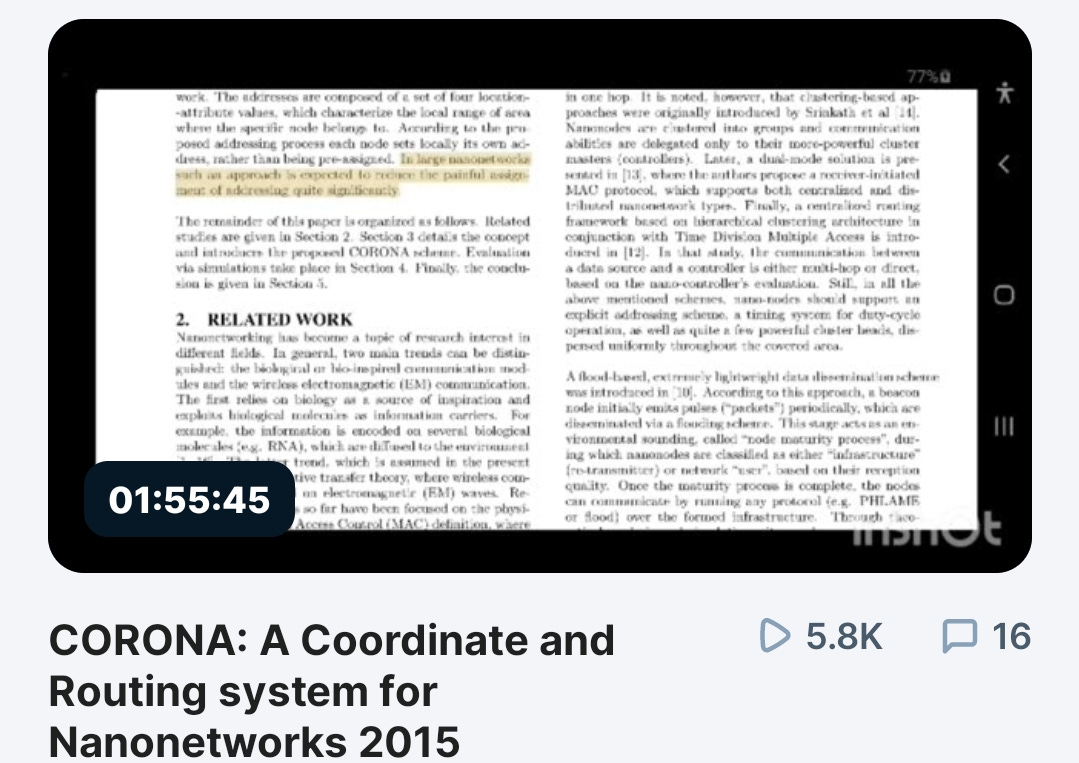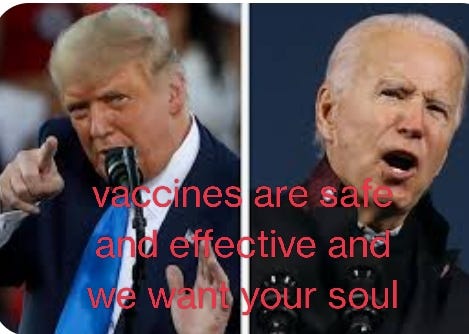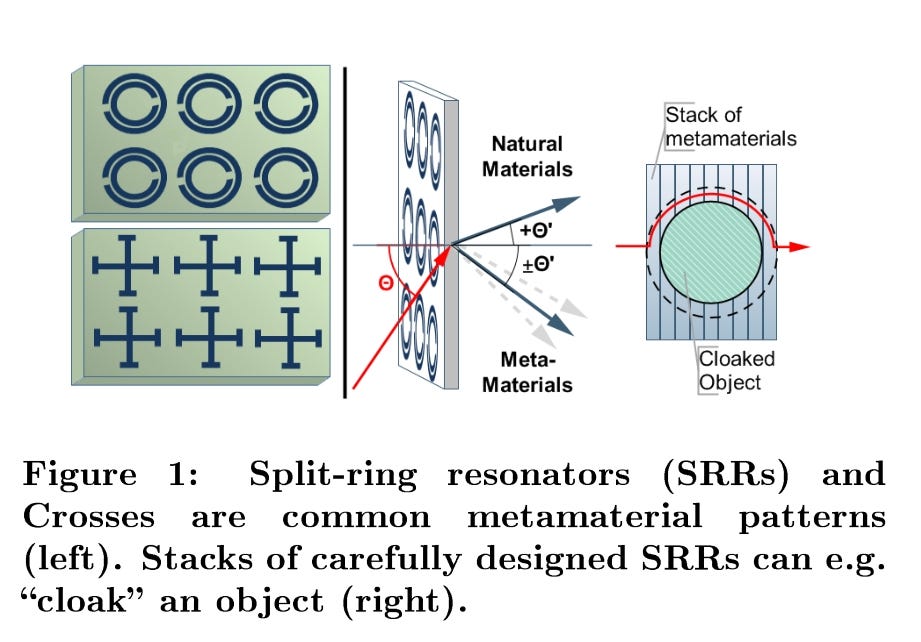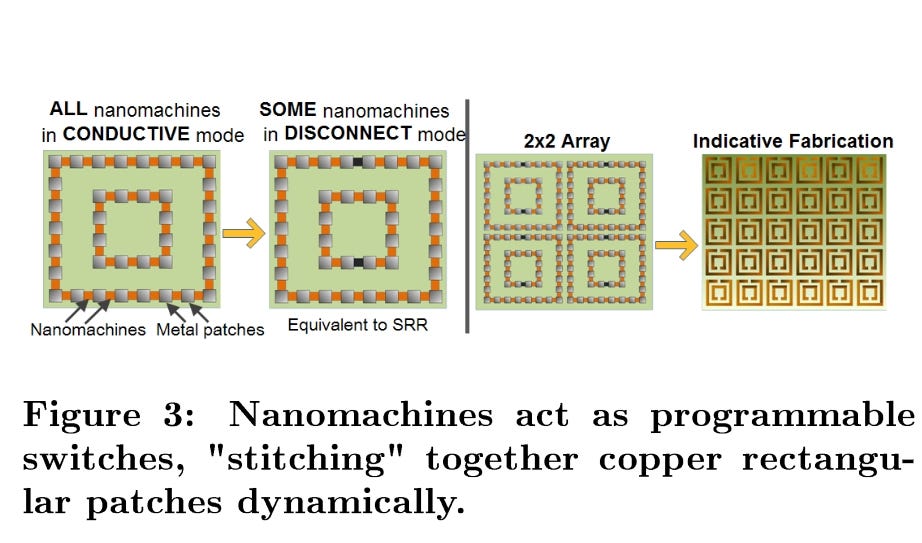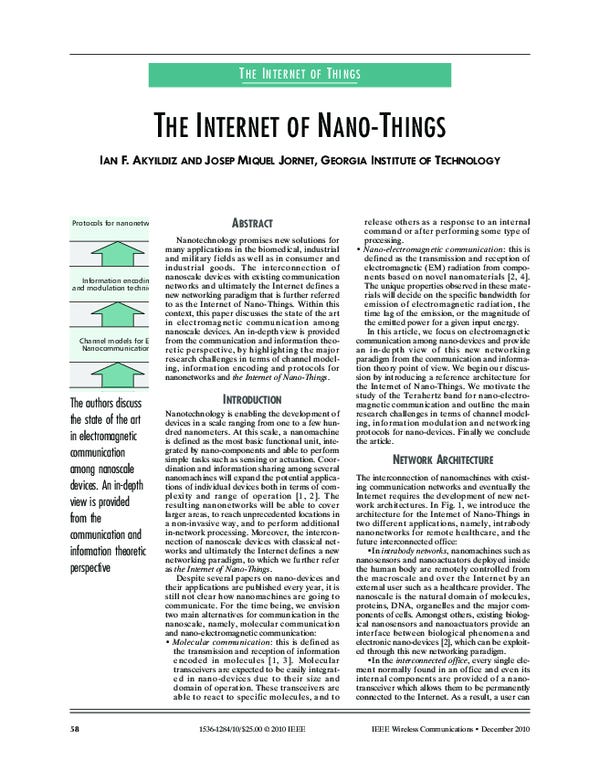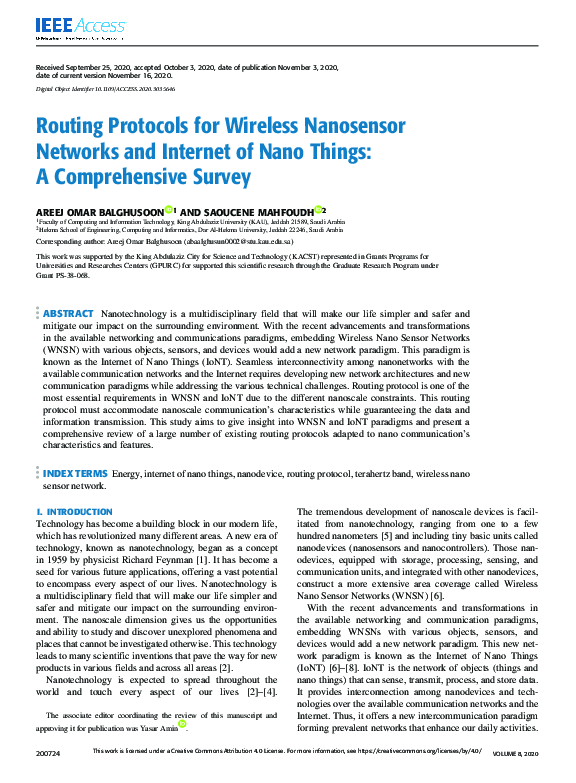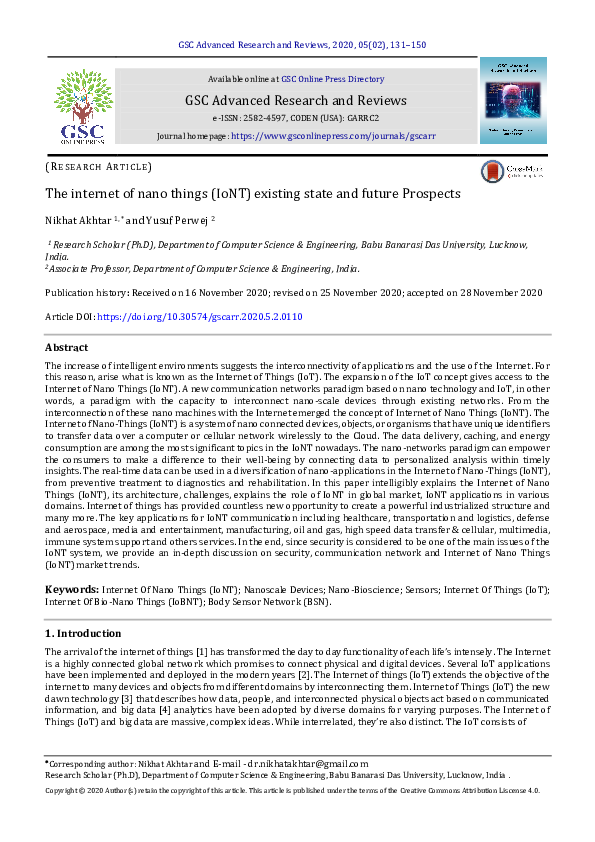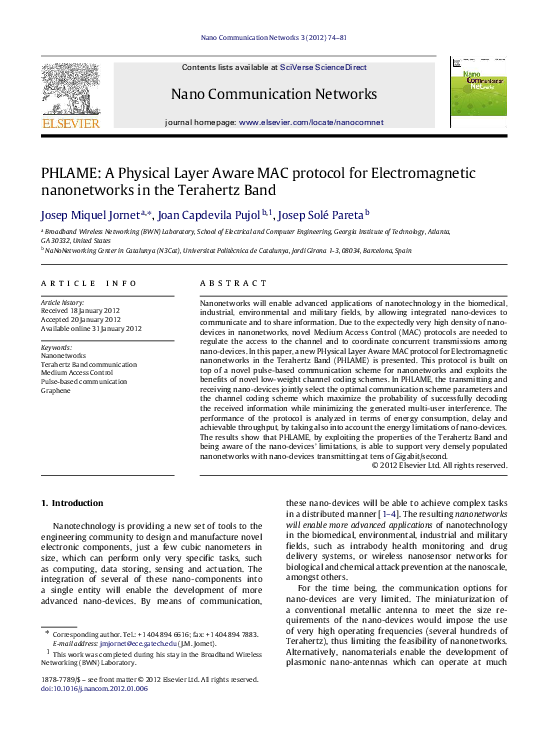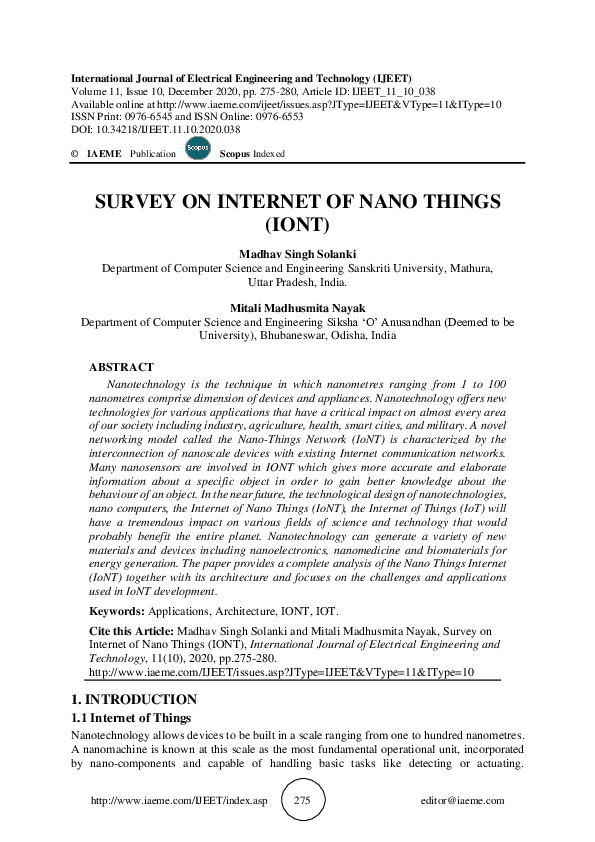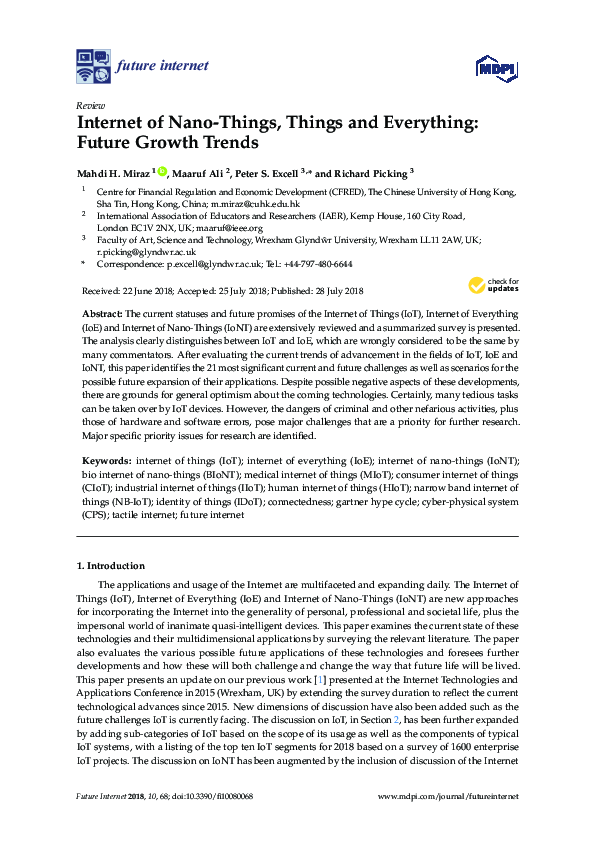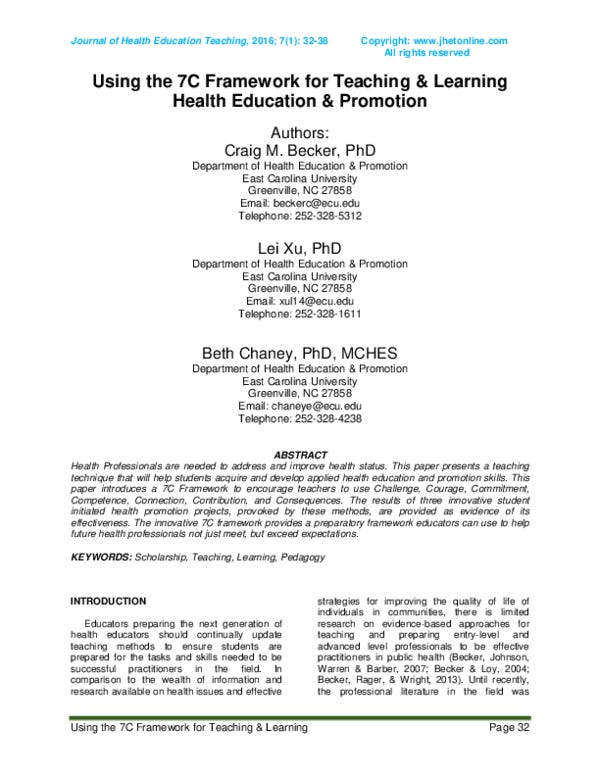https://rumble.com/v49y0sb-corona-a-coordinate-and-routing-system-for-nanonetworks-2015.html
SENSE.nano Symposium: Engineering the Nanoparticle Corona for Sensors, Michael Strano - MIT.nano 2017 "CORONA PHASE MOLECULAR RECOGNITION" https://rumble.com/v4am98u-january-31-2024.html
CORONA: A Coordinate and Routing system for Nanonetworks ABSTRACT
The present paper introduces a joint coordinate and rout- ing system (CORONA) which can be deployed dynamically on a 2D ad-hoc nanonetwork. User-selected nodes are used as anchor-points at the setup phase. All nodes then mea- sure their distances, in number of hops, from these anchors, obtaining a sense of geolocation. At operation phase, the routing employs the appropriate subset of anchors, selected by the sender of a packet. CORONA requires minimal setup overhead and simple integer-based calculations only, impos- ing limited requirements for trustworthy operation. Once deployed, it operates efficiently, yielding a very low packet retransmission and packet loss rate, promoting energy-efficiency and medium multiplexity. https://users.ics.forth.gr/~cliaskos/files/cnf/NANOCOM15.pdf Building Software Defined Materials with Nanonetwork ABSTRACT In this paper, we present a class of programmable materials,whose electromagnetic properties can be controlled via soft-ware. These Software Defined Materials (SDMs) stem from merging metamaterials with nanonetworks. Metamaterials are artificial structures with properties that may not be found in nature. They have inspired ground-breaking applications to a range of research topics, such as electromagnetic invis-ibility of objects (cloaking), radiation absorption, exquisite filtering of light and sound, as well as efficient antennas for sensors and implantable communication devices. However, existing metamaterial structures are "rigid", i.e. they cannot be restructured once constructed. This limits their fabrica-tion to a handful of well-equipped laboratories worldwide,slows down innovation, and, most importantly, restricts their applicability to static structures only. SDMs act as "plas-tic" (reconfigurable) metamaterials, whose properties can be changed programmatically via a computer interface. This control is achieved by a network of nanomachines, incorpo-rated into the very structure of the metamaterial. The nanoma-chines receive directives from a user and perform simple but geometry-altering actions on the metamaterial structure, tun-ing its electromagnetic behavior. The present paper intro-duces SDMs, defining the concept and highlighting its promis-ing future aspects. Presently realizable implementation ap-proaches are given, alongside specifications of a suitable nano-networking model, its unique challenges and promising resolution paths. https://projects.ics.forth.gr/tech-reports/2014/2014.TR447_Software_Defined_Materials_Nanonetworks.pdf Using Nano-wireless Communications in Micro-Robots Applications
ABSTRACT
The emergence of nano-electromagnetic communications ba-sed on graphene nano-antennas has opened new perspec-tives for communications between small things, referred as to the internet of micro-things or even as the internet of nano-things. However, these antennas make use of the Ter-ahertz band which raises many problems like the absorption of entire range of the available bandwidth by any molecule.Meanwhile, recent advances have been made in the design and fabrication of micro-robots enabling formation of micro-robots networks. Nano-antennas are an interesting way of communicating between micro-robots. We envision two types of benefits using integrated nano-antennas in micro-robots.First, nano-wireless communications could enhance exist-ing applications enabling a greater communication distance in an ensemble and broadcasting facilities. Second, nano-wireless communications can create new usage and new ap-plications. This article presents a simulation framework for micro-robots using nano-wireless communications and an application being developed within our simulator. https://www.researchgate.net/publication/266660191_Using_Nano-wireless_Communications_in_Micro-Robots_Applications
The Internet of Nano-Things Nanotechnology promises new solutions for many applications in the biomedical, industrial and military fields as well as in consumer and industrial goods. The interconnection of nanoscale devices with existing communication networks and ultimately the Internet defines a new networking paradigm that is further referred to as the Internet of Nano-Things. Within this context, this paper discusses the state of the art in electromagnetic communication among nanoscale devices. An in-depth view is provided from the communication and information theoretic perspective, by highlighting the major research challenges in terms of channel modeling, information encoding and protocols for nanonetworks and the Internet of Nano-Things. https://www.researchgate.net/publication/224208048_The_Internet_of_Nano-Things The Internet of nano-things
2000, IEEE Wireless Communications
Free PDF
Internet of Nano Things: Security Issues and Applications
Nanotechnology provides new solutions for numerous applications that have a significant effect on almost every aspect of our community including health monitoring, smart cities, military, agriculture, and industry. The interconnection of nanoscale devices with existing communication networks over the Internet defines a novel networking paradigm called the Internet of Nano-Things (IoNT). The IoNT involves a large number of nanosensors that used to provide more precise and detailed information about a particular object to enable a better understanding of object behaviour. In this paper, we investigate the challenges and opportunities of the IoNT system in various applications. An overview of the IoNT is first introduced. This is followed by a discussion of the network architecture of the IoNT and various applications that benefit from integrating IoT with nanotechnology. In the end, since security is considered to be one of the main issues of the IoNT system, we provide an in-depth discussion on security goals, attack vectors and security challenges of the IoNT system.
Free PDF
IEEE Access
Free PDF
The Internet of Nano Things (IoNT) Existing State and Future Prospects
Dr. Yusuf Perwej, Nikhat Akhtar
2020, GSC Advanced Research and Reviews (GSCARR), e-ISSN: 2582-4597
The increase of intelligent environments suggests the inter-connectivity of applications and the use of the Internet. For this reason, arise what is known as the Internet of Things (IoT). The expansion of the IoT concept gives access to the Internet of Nano Things (IoNT). A new communication networks paradigm based on nano technology and IoT, in other words, a paradigm with the capacity to interconnect nano-scale devices through existing networks. From the interconnection of these nano machines with the Internet emerged the concept of Internet of Nano Things (IoNT). The Internet of Nano-Things (IoNT) is a system of nano connected devices, objects, or organisms that have unique identifiers to transfer data over a computer or cellular network wirelessly to the Cloud. The data delivery, caching, and energy consumption are among the most significant topics in the IoNT nowadays. The nano-networks paradigm can empower the consumers to make a difference to their well-being by connecting data to personalized analysis within timely insights. The real-time data can be used in a diversification of nano-applications in the Internet of Nano-Things (IoNT), from preventive treatment to diagnostics and rehabilitation. In this paper intelligibly explains the Internet of Nano Things (IoNT), its architecture, challenges, explains the role of IoNT in global market, IoNT applications in various domains. Internet of things has provided countless new opportunity to create a powerful industrialized structure and many more. The key applications for IoNT communication including healthcare, transportation and logistics, defense and aerospace, media and entertainment, manufacturing, oil and gas, high speed data transfer & cellular, multimedia, immune system support and others services. In the end, since security is considered to be one of the main issues of the IoNT system, we provide an in-depth discussion on security, communication network and Internet of Nano Things (IoNT) market trends.
Free PDF
PHLAME: A Physical Layer Aware MAC protocol for Electromagnetic nanonetworks in the Terahertz Band
2012, Nano Communication Networks
Free PDF
SURVEY ON INTERNET OF NANO THINGS (IONT)
2020, IAEME PUBLICATION
Nanotechnology is the technique in which nanometres ranging from 1 to 100 nanometres comprise dimension of devices and appliances. Nanotechnology offers new technologies for various applications that have a critical impact on almost every area of our society including industry, agriculture, health, smart cities, and military. A novel networking model called the Nano-Things Network (IoNT) is characterized by the interconnection of nanoscale devices with existing Internet communication networks. Many nanosensors are involved in IONT which gives more accurate and elaborate information about a specific object in order to gain better knowledge about the behaviour of an object. In the near future, the technological design of nanotechnologies, nano computers, the Internet of Nano Things (IoNT), the Internet of Things (IoT) will have a tremendous impact on various fields of science and technology that would probably benefit the entire planet. Nanotechnology can generate a variety of new materials and devices including nanoelectronics, nanomedicine and biomaterials for energy generation. The paper provides a complete analysis of the Nano Things Internet (IoNT) together with its architecture and focuses on the challenges and applications used in IoNT development.
Free PDF
Internet of Nano-Things, Things and Everything: Future Growth Trends
2018, Future Internet
The current statuses and future promises of the Internet of Things (IoT), Internet of Everything (IoE) and Internet of Nano-Things (IoNT) are extensively reviewed and a summarized survey is presented. The analysis clearly distinguishes between IoT and IoE, which are wrongly considered to be the same by many commentators. After evaluating the current trends of advancement in the fields of IoT, IoE and IoNT, this paper identifies the 21 most significant current and future challenges as well as scenarios for the possible future expansion of their applications. Despite possible negative aspects of these developments, there are grounds for general optimism about the coming technologies. Certainly, many tedious tasks can be taken over by IoT devices. However, the dangers of criminal and other nefarious activities, plus those of hardware and software errors, pose major challenges that are a priority for further research. Major specific priority issues for research are identified.
Free PDF
ﳏﻜﻤﺔ ﻋﻠﻤﻴﺔ ﳎﻠﺔ ﻟﻌﺮﺑﻴﺔ ﻭﺍ ﺍﻹﺳﻼﻣﻴﺔ ﻟﺒﺤﻮﺙ ﺍ ﻓﻰ اﻟﻌﺪد اﻟﺴﺎﺑﻊ و اﻟﺜﻼﺛ ﻴ ﻦ
Using the 7C Framework for Teaching & Learning Health Education & Promotion
Health Professionals are needed to address and improve health status. This paper presents a teaching technique that will help students acquire and develop applied health education and promotion skills. This paper introduces a 7C Framework to encourage teachers to use Challenge, Courage, Commitment, Competence, Connection, Contribution, and Consequences. The results of three innovative student initiated health promotion projects, provoked by these methods, are provided as evidence of its effectiveness. The innovative 7C framework provides a preparatory framework educators can use to help future health professionals not just meet, but exceed expectations.
Free PDF
.
2019, Fertility and Sterility About
AI for Good is a year-round digital platform where AI innovators and problem owners learn, build and connect to identify practical AI solutions to advance the UN SDGs https://aiforgood.itu.int/about-ai-for-good/#:~:text=The%20goal%20of%20AI%20for,United%20Nations%20platform%20on%20AI.
Isaiah 54:17 "No weapon that is fashioned against you shall prosper..." "No weapon that is fashioned against you shall prosper, and you shall confute every tongue that rises against you in judgment. This is the heritage of the servants of the Lord and their vindication from me, says the LordThanks for all that you do to stop this biohack on all that is natural and made in the image of GOD and may Romans 8:31 be our guiding light. 6831





